-
Google Trends is a free tool that displays search query trends across Google and YouTube search engines. It provides fresh data on relative search volumes, geographic interest, and trending topics.
-
Identify high-potential SEO opportunities and emerging content topics by using Google Trends data. Get comprehensive keyword research by analyzing search volume trends, related topics and queries, and comparing multiple search terms.
-
Monitor seasonal trends and search behavior patterns to optimize your content strategy, timing blog posts and social media content for maximum impact during peak interest periods.
-
Use Google Trends to discover current trends and viral topics. Access the Trending Now page to compare search patterns and find out which content format is best (blog posts vs. video content) and develop targeted content marketing approaches.
-
Use Google Trends to boost your local SEO efforts by analyzing regional search variations and interest patterns, helping to identify location-specific keywords and market opportunities for targeted content creation.
-
Use Google Trends to track competitive trends and related topics to uncover content gaps and benchmark your performance against competitors.
-
Use Google Trends to enhance your video content strategy by analyzing YouTube search trends. Plan your video content by checking which topics maintain steady interest and which related queries gain popularity.
We won’t say you can’t сreate content based on whatever topic comes to mind, but that’s a gamble-and-a-half. It just isn’t a solid business approach for managing your website and other business profiles. All of your content ideally should be backed by research (especially SEO-related research), and it’s more difficult to do this without using special online tools that give you access to different kinds of data.
One of these tools is Google Trends, which can reveal what people worldwide are interested in. Let’s look at what Google Trends is and how to use it for SEO and content marketing.
What is Google Trends and how does it work?
Google Trends is a free tool that shows which topics are trending around the globe at a given time across Google and YouTube search engines. This tool presents how popular certain search queries are, their relative search volume and dynamics, and which locations they generate the highest interest in. Google Trends analyzes samples of search data to measure user interest across various topics and then conveniently presents it as a graph. The best part is that Google Trends is readily available to everyone, so you don’t need to create an account like you would with Google Analytics or Google Search Console.
Google Trends has two primary tabs, Explore (mainly for keyword research) and Trending Now (can also be useful for finding trending topics). There is an additional tab, Year in Search, which is a brief overview of the popular searches of the last year.
Google Trends covers 20 years and provides fresh data renewed within minutes. It spots events from big to small, global to local, and everything in between. It knows that every four years the entire world rushes to discuss the Olympics for about two weeks. It also knows that the “Tesla Optimus” term was on everybody’s lips for days after Elon Musk unveiled the second-generation humanoid robot at the 2024 World Artificial Intelligence Conference in Shanghai.
How to use Google Trends for SEO
One of the most straightforward ways to use Google Trends is to identify the top-performing keywords and incorporate them into your website for better SEO. You can use a dedicated keyword tracking tool to monitor your SEO progress and make improvements. Google Trends helps you find plenty of opportunities to support your SEO and marketing strategies, regardless of the business you’re in. There are numerous ways to utilize Google Trends.
Let’s go through the most common use cases below.
Conduct keyword research
Google Trends is one of the basic tools for keyword research. While it’s not very sophisticated for in-depth SEO keyword research, it still provides valuable data on what people in specific countries search and how that interest changes over time.
The Explore section is the most useful tool for keyword research with Google Trends. It’s accessible via the left sidebar or top menu, with information on all search queries whose search volume is higher than zero. You’ll definitely find some keyword ideas there.
Find related queries similar to the seed keyword
To get started, enter the seed keyword into the search box directly from your home screen.
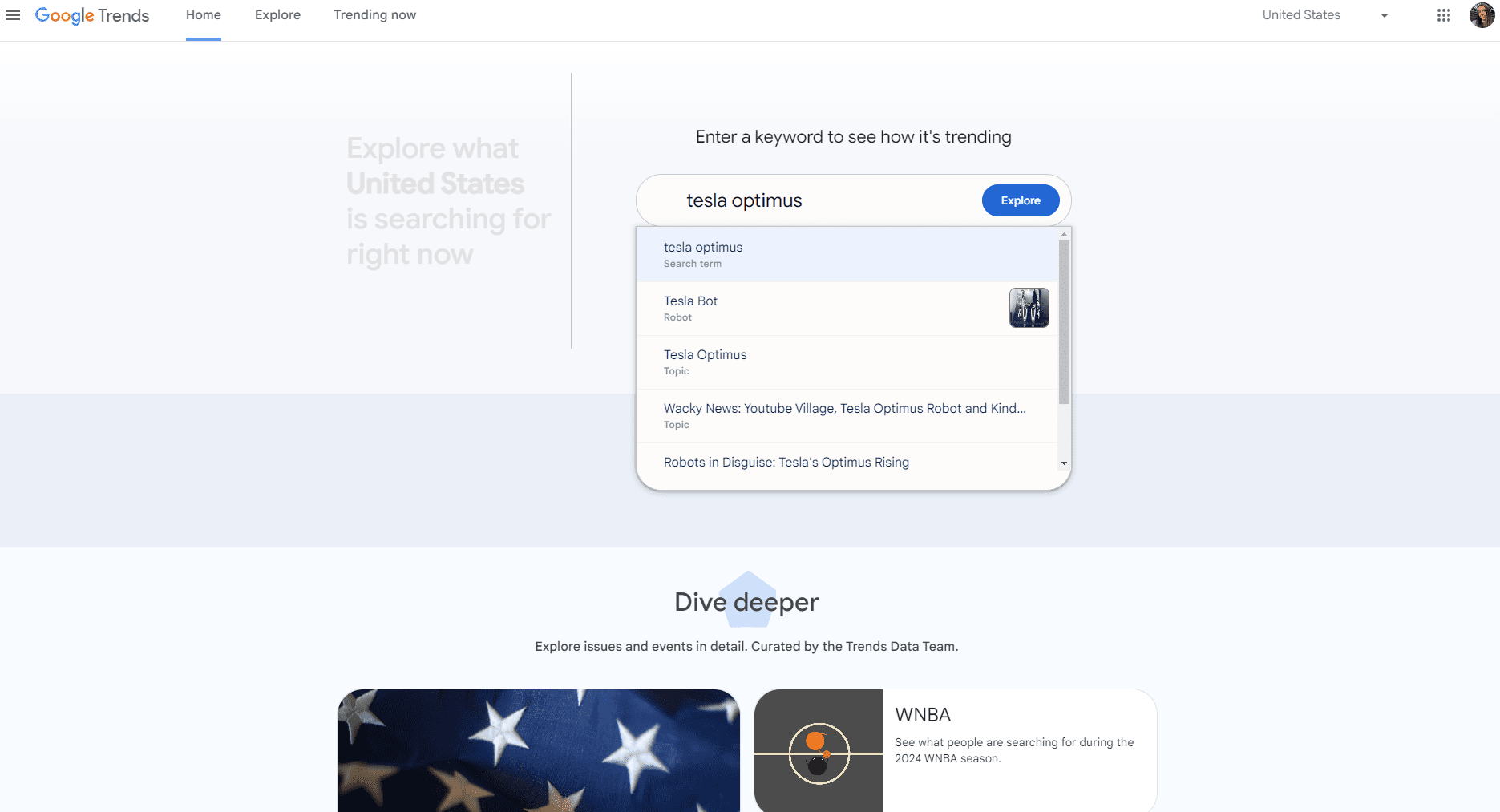
Then, simply click the Explore button to proceed. Find the Related topics and Related queries tabs at the very bottom of the Explore section.
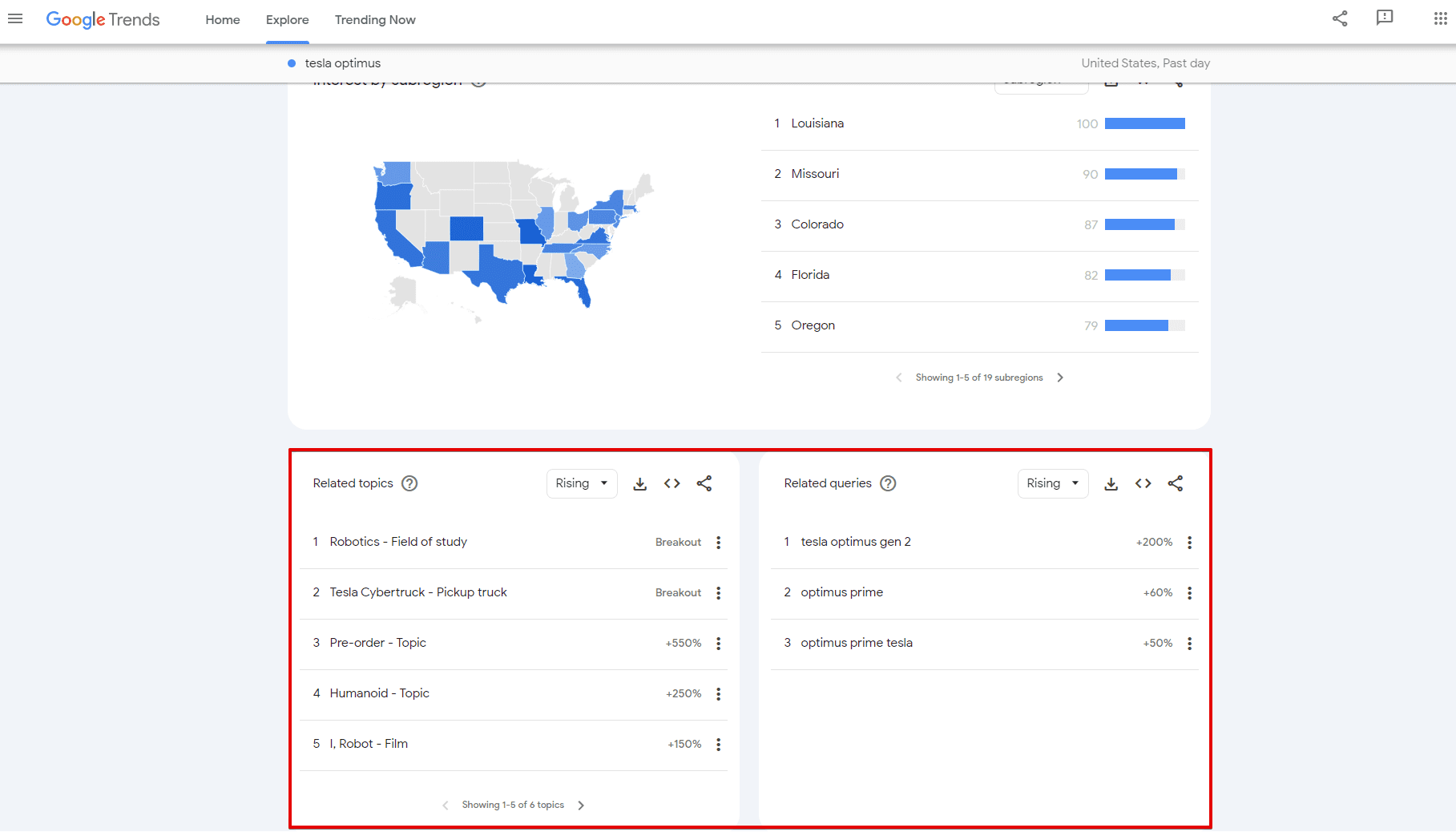
Here, you can switch between Top and Rising modes. In the first case, you’ll see the most popular search queries and their interest score, with 100 being the highest point of interest and 0 being the lowest.
The second mode, Rise, shows search queries with the biggest increase in search volume over a defined time period. This normally shows the percentage of a keyword’s growth where its current state is compared to a previous time period. You may notice that the percentage is replaced with the word “Breakout” in Google Trends, also known as breakout keywords. According to Google, this means that Google doesn’t have enough data to show a clear percentage change. Instead, it indicates that the keyword grew by over 5000% during that time period.
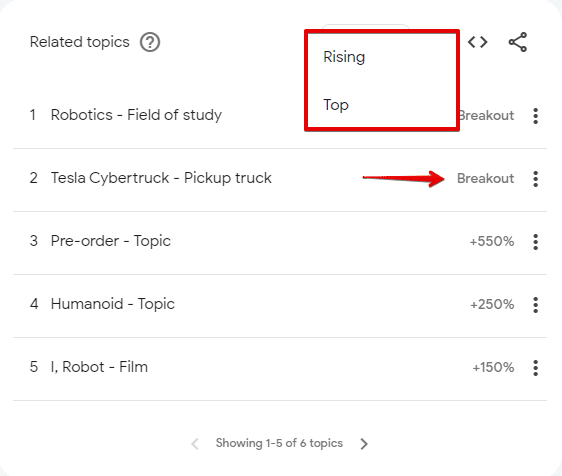
When entering your search query into the search box, you can choose whether to discover it as a topic/category or as a search term. The first option is better because you may otherwise get irrelevant keyword suggestions. For example, if you choose to discover fashion as a search term, and not as a topic, keywords like A Christmas in Royal Fashion (which is a film name) will pop up among the related topics.

To succeed in your keyword research, be creative with your seed keywords. Start with a broad term like fashion, but be specific and explore narrower terms to get good topic ideas. For example, fashion media often write about high-end expensive designer clothing, so exploring the term haute couture is a good idea.
Use different filters to get relevant results:
- Consider location. You can search worldwide or in a specific country. For instance, if you have a small local company in the UK, you can check what’s trending in your region.
- Pick the period that works best for your query. By default, Google Trends analyzes the last 12 months, but other options, like “past hour” or “since 2004” are available. For our fashion topic example, you’ll want to get insights into recent news, which means you should choose a period between the last couple of hours and over the week.
- Choose your category. You may also restrict your search to a certain category or subcategory from the suggested list. You have 25 categories with multiple subcategories to choose from.
- Select your data source. Refine your search based on the most relevant platform to your needs. Google Trends uses data from Google Search, Google News, Google Images, Google Shopping, and YouTube.
- Use advanced Google search operators. Dig deeper into the data to extract actionable user query results by using search operators.
- Quotation marks (“”) help you find exact match queries. For instance, “how to cook fish” will show data only for this exact phrase. It will filter out variations like “cooking fish” or “fish recipes.” This is useful when you want to target long-tail keywords.
- The minus sign (–) lets you exclude certain terms from your search. For example, “fish recipes -tuna” will show trends for fish recipes but exclude searches related to tuna. This helps you focus on specific market segments.
- The plus sign (+) combines different search terms. When you search for “salmon + trout recipes,” you’ll see trend data for searches containing either salmon or trout recipes. This broader view helps you understand the overall level of topic interest.
Get ideas with no seed keyword
Google Trends lets you explore search terms that aren’t related to any topic, like “how to” or “what is”, to get keyword ideas. Use the category filter to specify the (sub)category you’re interested in and find a list of new trending queries and topics relevant to your niche. No other tool offers this because traditional keyword research solutions require you to be more specific from the get-go.
Compare and analyze several keywords at a time
Another unique Google Trends feature is the simultaneous analysis of various specific keywords. If you have several promising keywords to choose from and can’t decide which one to start the ranking process for, you can compare them side by side and pick the one showing a more positive trend. This feature allows you to analyze up to five terms simultaneously, providing insights into their relative popularity.
In the example below, it looks like the trend is changing in favor of the “android” keyword.
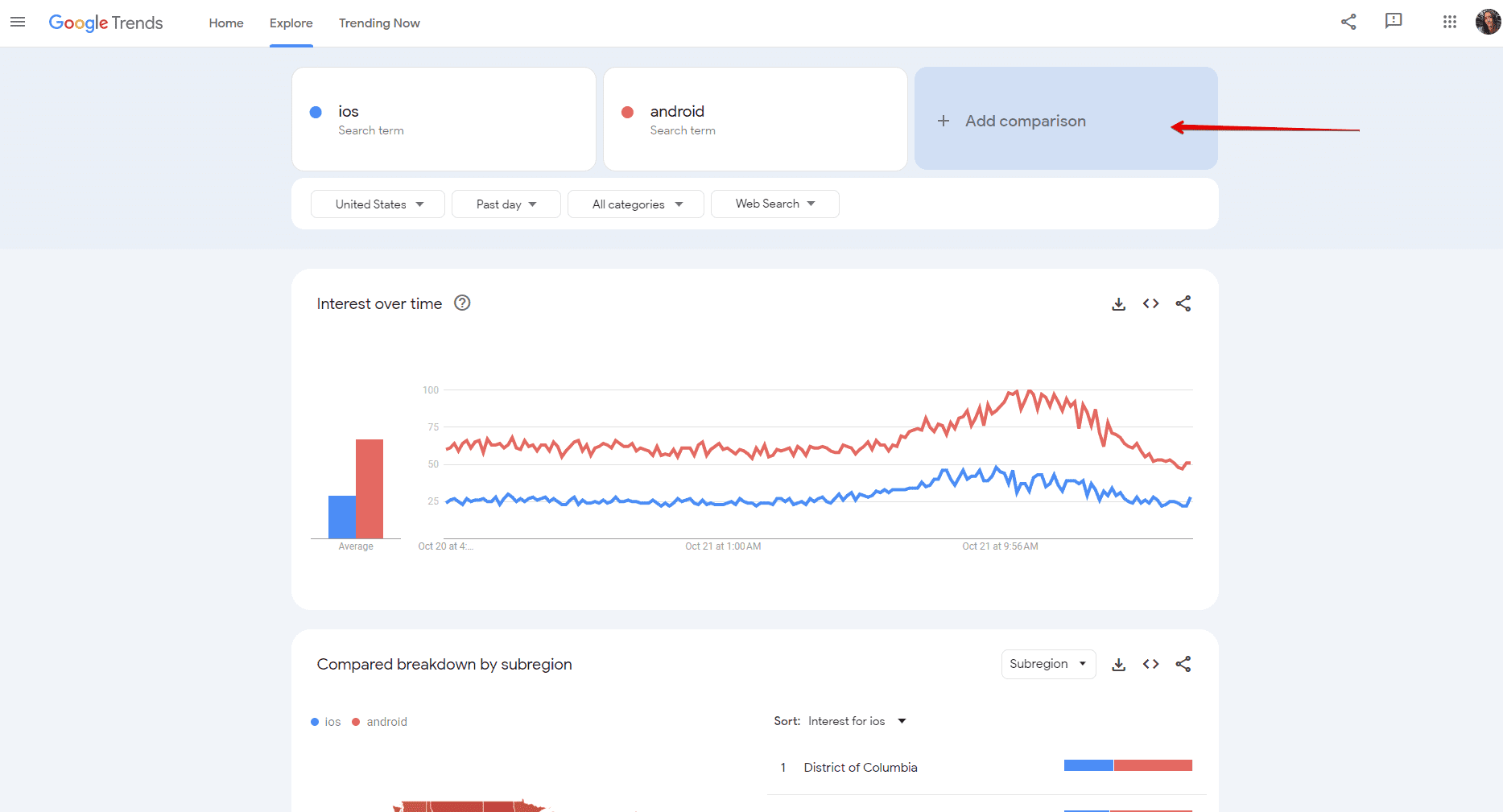
You can compare terms across different locations to understand geographic variations in interest, such as between countries or cities. Comparing by **** is another useful option. It helps you analyze how the interest in terms has changed or how multiple terms compare from within the same time frame.
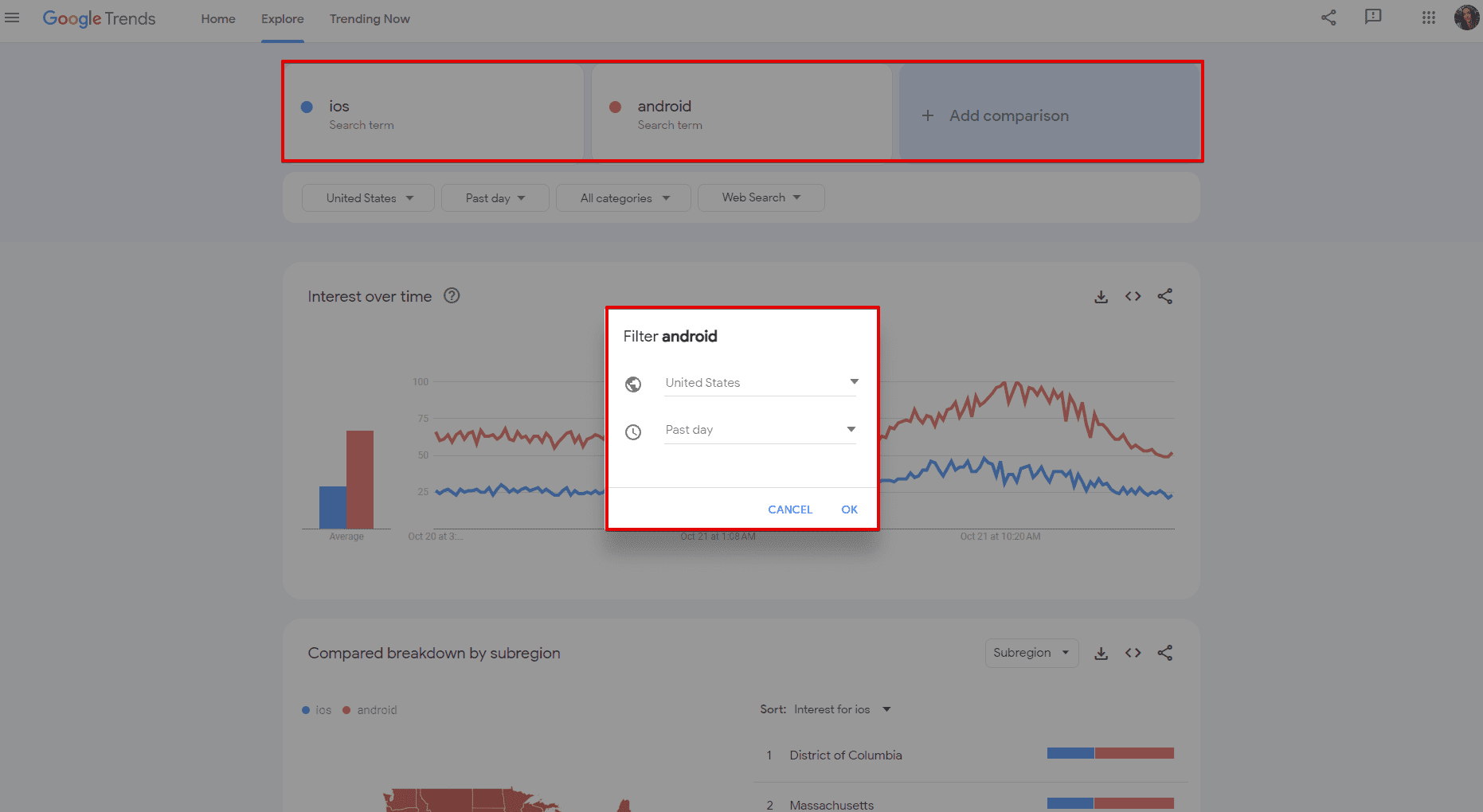
Simultaneous analysis also shows you the expected volume of traffic from a new keyword. The process is as simple as taking the keyword you rank for that already brings you traffic and then comparing it to a new search query. This helps you filter out keywords without the potential to bring you traffic. You can then add them to a dedicated Google keyword rank checker and keep track of their performance.
Analyze seasonal trends to plan blog and social media content
Spot time-sensitive keywords and find evergreen topics
Another undeniable benefit of Google Trends is that it pins down the search terms whose search volume spikes and then rapidly goes back to zero in under a week—like names of new fragrances presented by fashion houses.
Traditional keyword research tools usually don’t update their databases in real time, which means they may not have any data on time-sensitive keywords. Google Trends acts as an extra pair of eyes that helps you see keyword opportunities you might have otherwise easily missed, like fast-moving trends or popular how-to queries.
Having razor-sharp vision like this is key if you run an SMM campaign and need to stay on top of current trends. But consider the difference between trends and fads. Trends are topics that spike around the same time each year and can be considered evergreen. For example, “Halloween costumes” is a trend that peaks annually in October. Fads, on the other hand, spike once and then fade away, like a viral dance challenge on TikTok that’s popular for a few weeks and then forgotten. Also, Google Trends should serve as an additional way to find content ideas, but it should not replace traditional keyword research tools.
Our SEO Keyword Generator is one of those tools. It helps you discover long-lasting topics and build a solid keyword list that can later be clustered. It provides essential data for optimizing pages for search intent, finding promising focus keywords, and checking SERPs for needed keywords.
You can start your traditional keyword research with our Keyword Tool by entering your seed keyword, choosing the location, and then getting a bunch of similar, related, low search volume and question-based keyword ideas with essential data like search volume, difficulty, search intent, SERP features, and more.
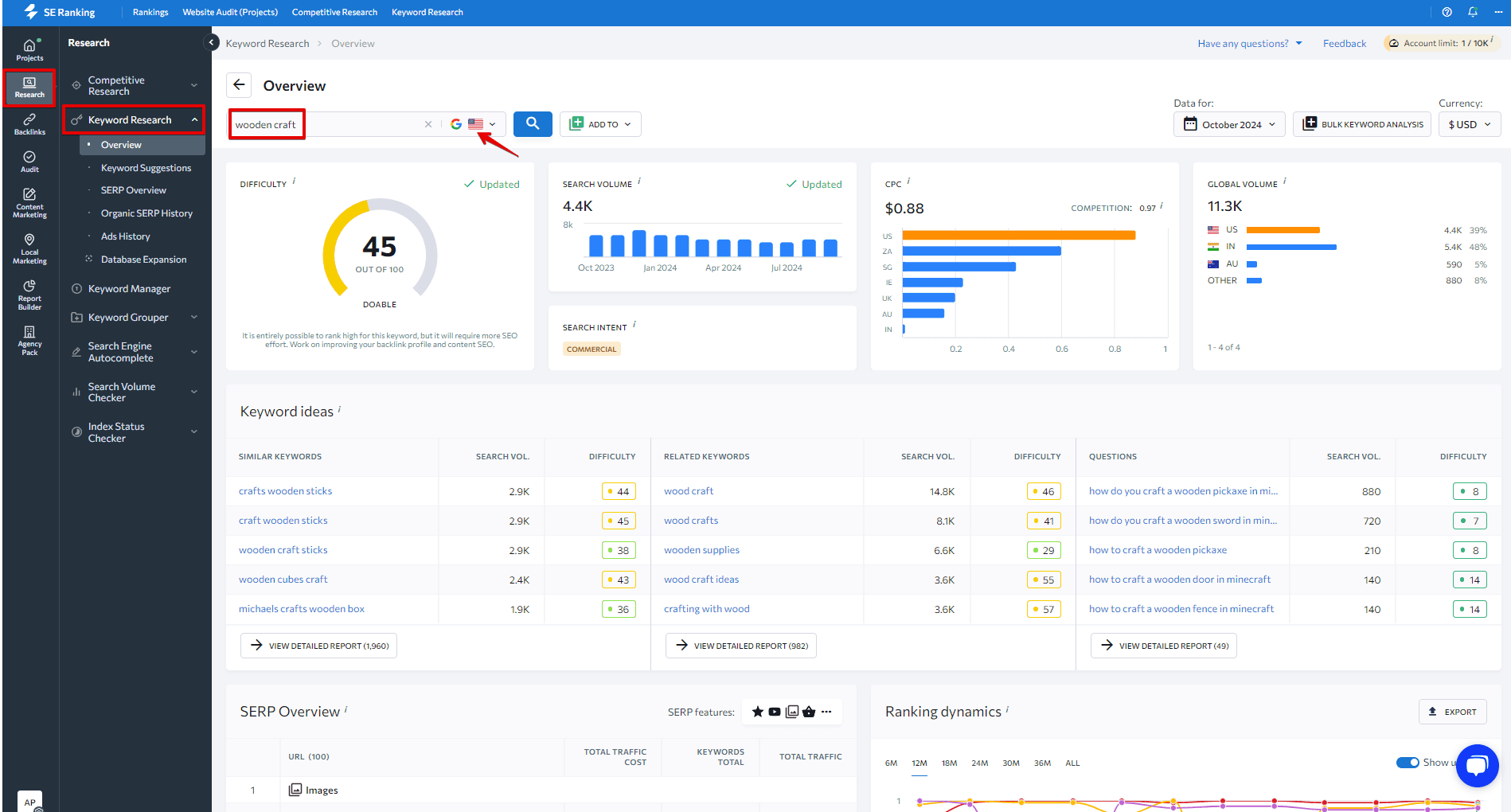
Once you’re done, use Google Trends to get tons of insights to expand or clean your keyword list.
Analyze the keyword popularity curve
Only take on keywords with stable public interest. To check if this is the case, enter the keyword into the Google Trends search box and check the Interest over time graph.
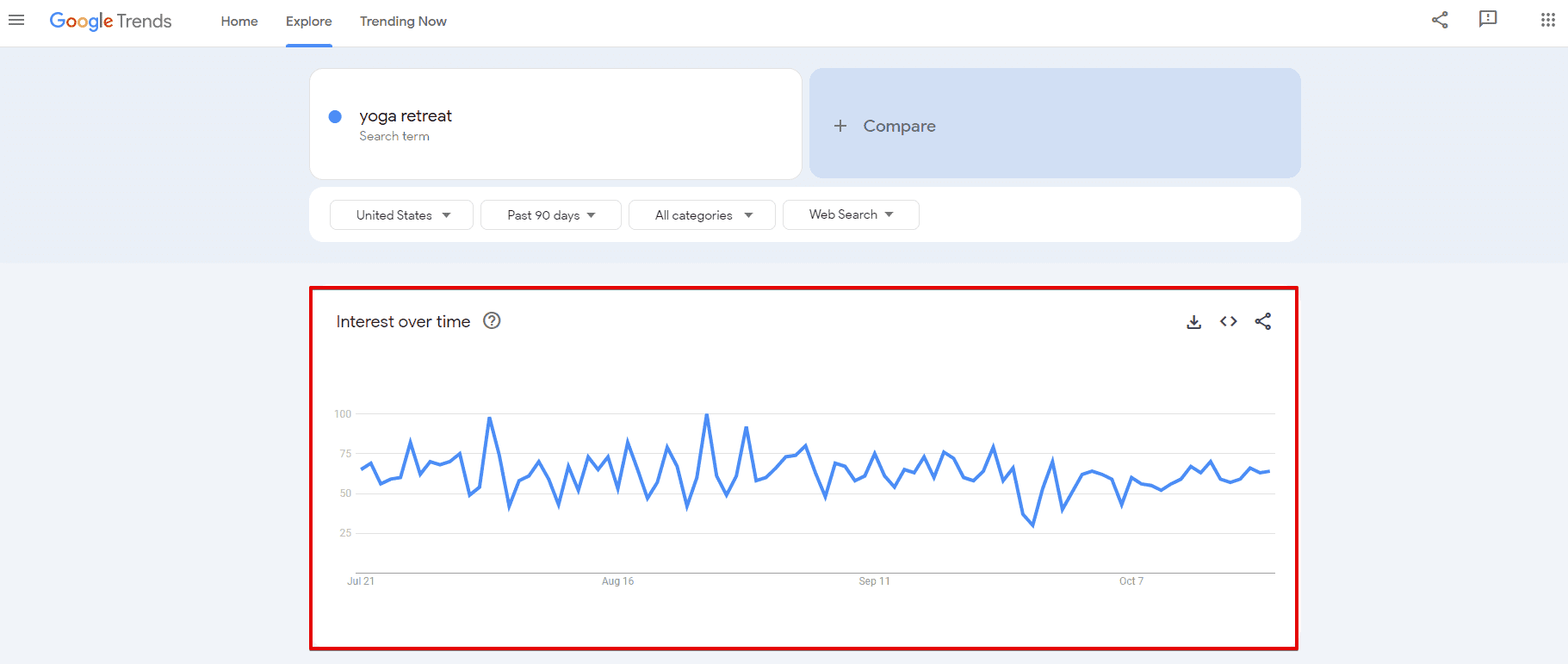
In addition to validating new keywords, the graph can also be used to check up on the keywords you’re currently targeting. If you noticed that some keywords began bringing in less traffic at one point and that this downward trend persists, chances are their days of glory are ending. Check the popularity graph to see if your keywords are losing public interest. If so, you’ll have to look for new keyword opportunities.
You may occasionally want to use Google Trends to see the bigger picture.
You may encounter a “keyword unicorn” every now and again, which is a keyword whose popularity once skyrocketed but soon went back to nearly zero.
You would typically drop these keywords, but sometimes what seems like a unicorn may turn out to be a seasonal keyword. So, if you suspect this to be the case, you’ll have to go to Google Trends to check this out.
Stay on top of seasonal fluctuations
To analyze seasonality, change the default time span set in Google Trends from 12 months to 5 years. This is so you can spot if the surge in a keyword’s popularity occurs every year at a particular time. Seasonal keywords aren’t useless like keyword unicorns, so you can go ahead and keep them on your list. However, you’ll have to treat them differently than regular keywords and plan your marketing campaigns according to their seasonal nature.
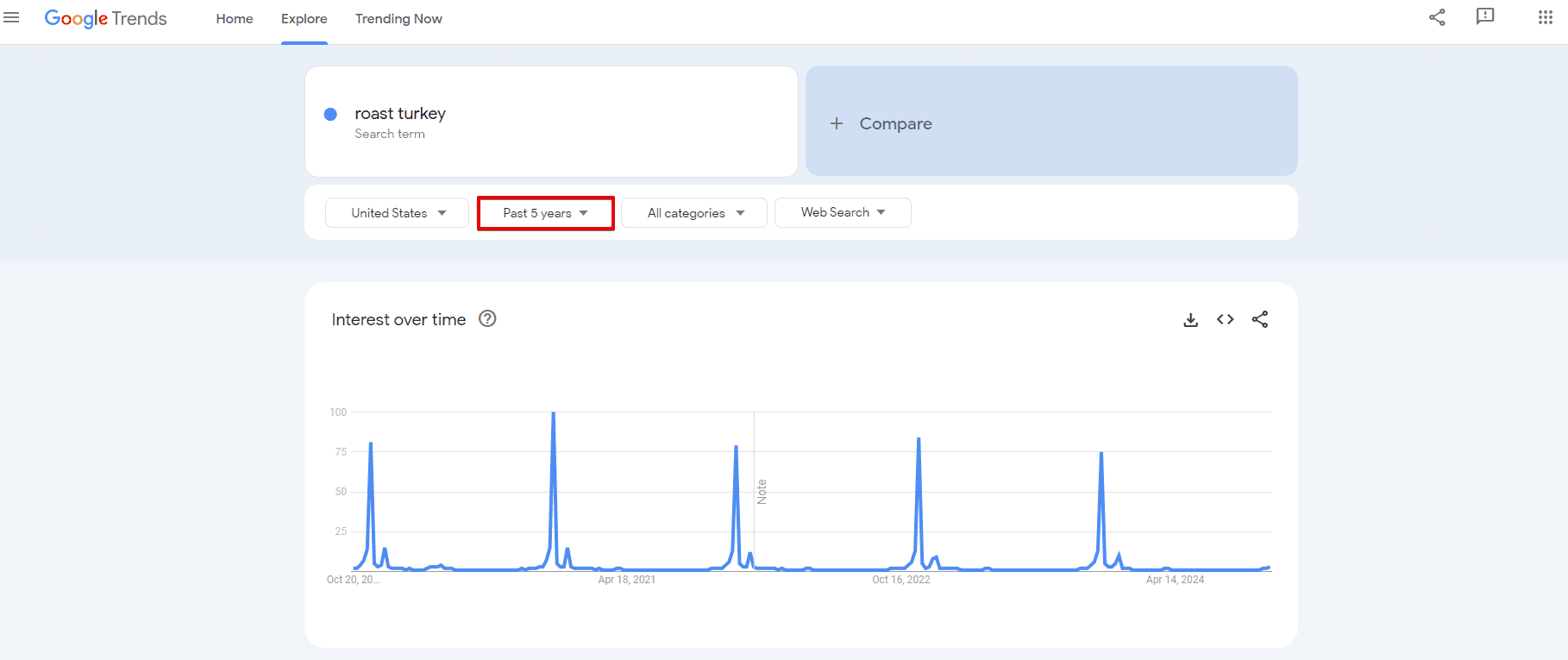
Use Google Trends data to understand when exactly a keyword’s popularity starts growing. For instance, everybody knows that people search for costume rentals the most around Halloween. People also need summer shoes for summer. But with Google Trends, you can get more precise data. It will show you that people start looking for Halloween outfits at the beginning of October, and the “summer shoes” keyword begins getting more searches in late spring with the peak observed at the end of May/beginning of June.
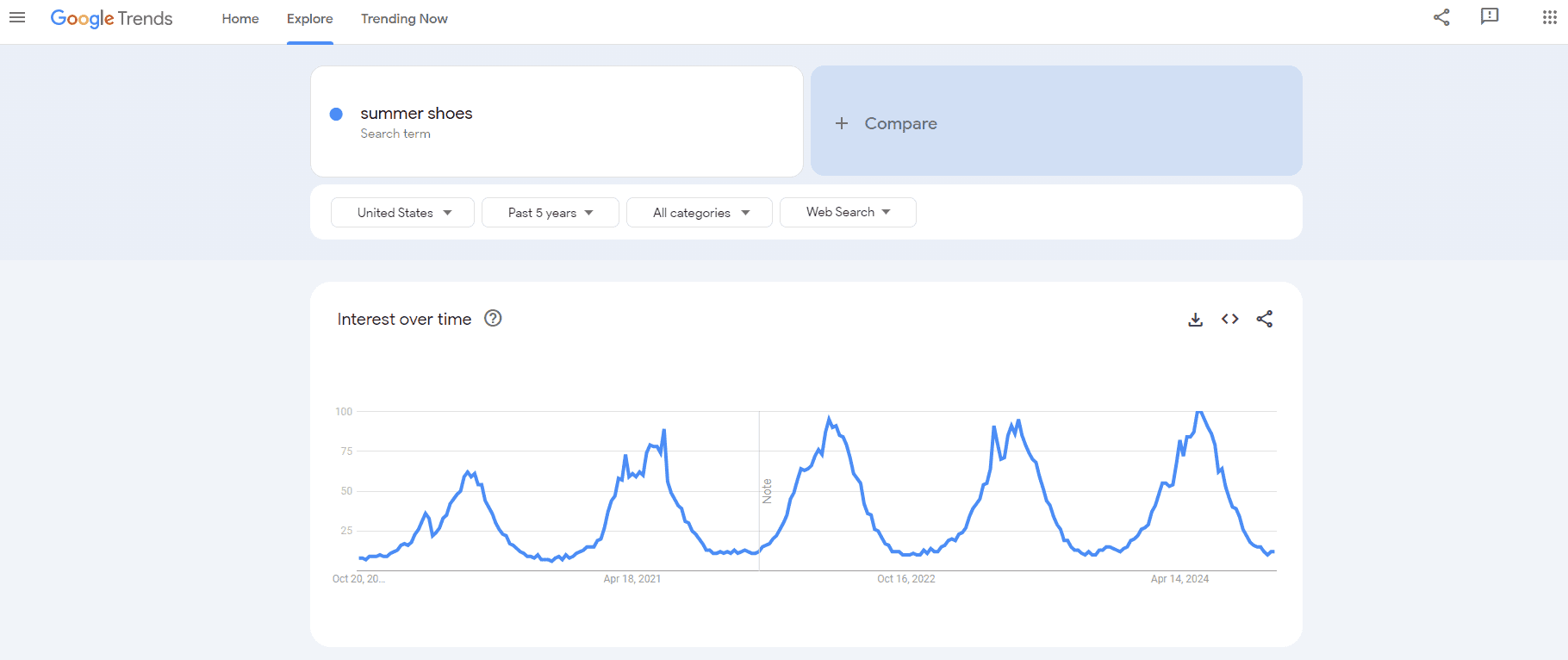
To get the most relevant results, be precise in your wording. Try to use the search terms your customers or readers use. So if you’re selling summer shoes and not writing a fashion column about shoe trends, just go for the “buy summer shoes” keyword.
Identifying where the curve of interest starts growing can help marketers plan and start their campaigns at the right time. A shoe shop, for example, can start promoting summer shoes on Facebook at the beginning of May, meaning they need to adjust their content plan and have all the texts published earlier in April. Publishing content before the seasonal interest in a topic starts growing also gives a business time to build useful backlinks.
Updating cornerstone content before seasonal peaks is also a good idea because both users and Google value fresh content. If, let’s say, you run a travel blog and you have a post on a trip to Brazil during the Carnival, it makes sense to update it in January when interest in the topic starts growing.
Create a content calendar around trending search queries
Understand in-demand content types
You can also use Google Trends to identify the best content type for your goals, among other marketing or SEO tasks. By default, Google Trends uses web search data when analyzing search terms. But this tool also contains data from Google’s image search and YouTube, helping you determine which content type is more popular among users. Some keywords can produce better results when paired with the right content type, like creating a video for your YouTube channel instead of writing another blog post.
If the search term would make for a good blog post and video, look at its trend curve under the web search tab and then check YouTube’s search results. Go for the one that looks more promising or create both a blog post and a video if the query is equally popular in web searches and on YouTube.
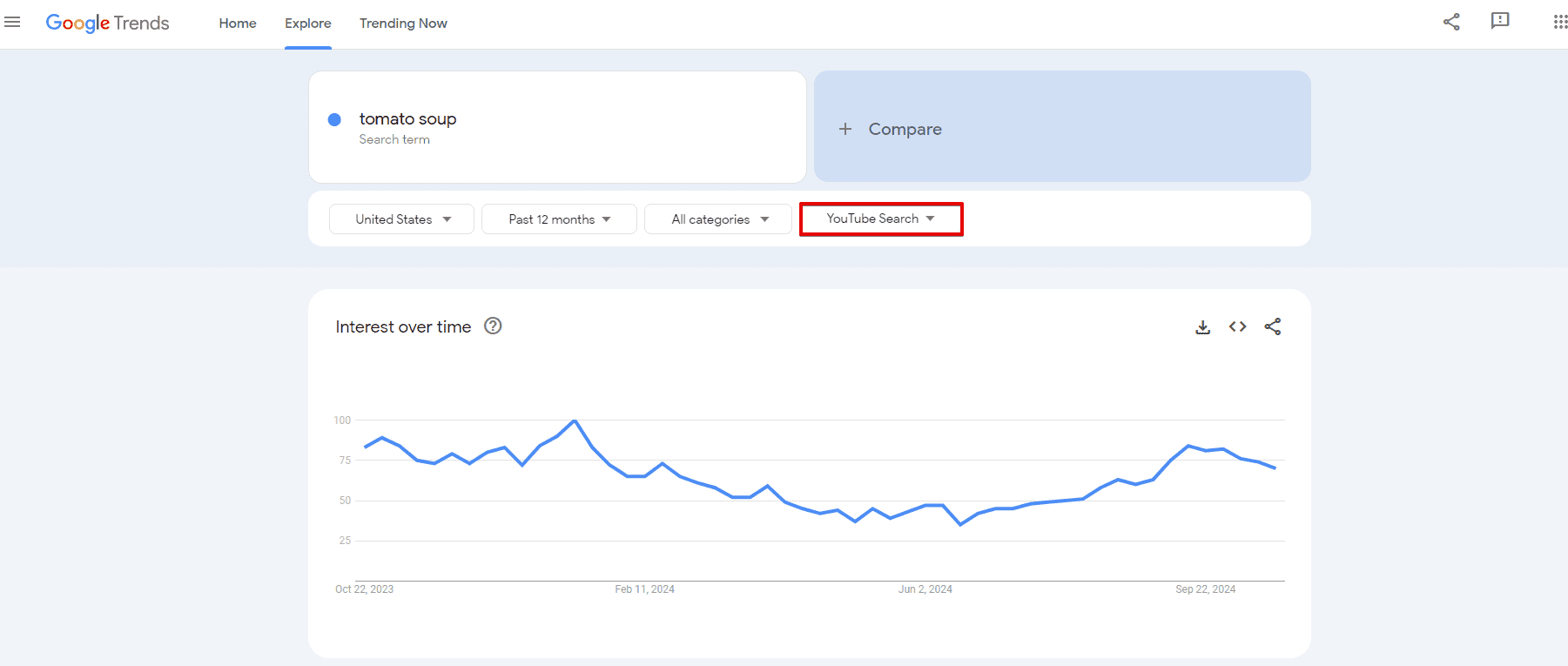
You can also check if a keyword is trending on Google Images. If this is the case, consider creating an infographic or an explanatory image on the topic. It will help you stand out in Google’s image search and can get you a lot of clicks on your website.
Identify trending topics to cover in your niche
Another way to use Google Trends for market research is to explore the Trending Now tab, staying on top of all newsworthy events relevant to your business niche. If a story has recently made the news, you can find it in the tool’s Trending Now section, which can be accessed from the left sidebar or top menu.
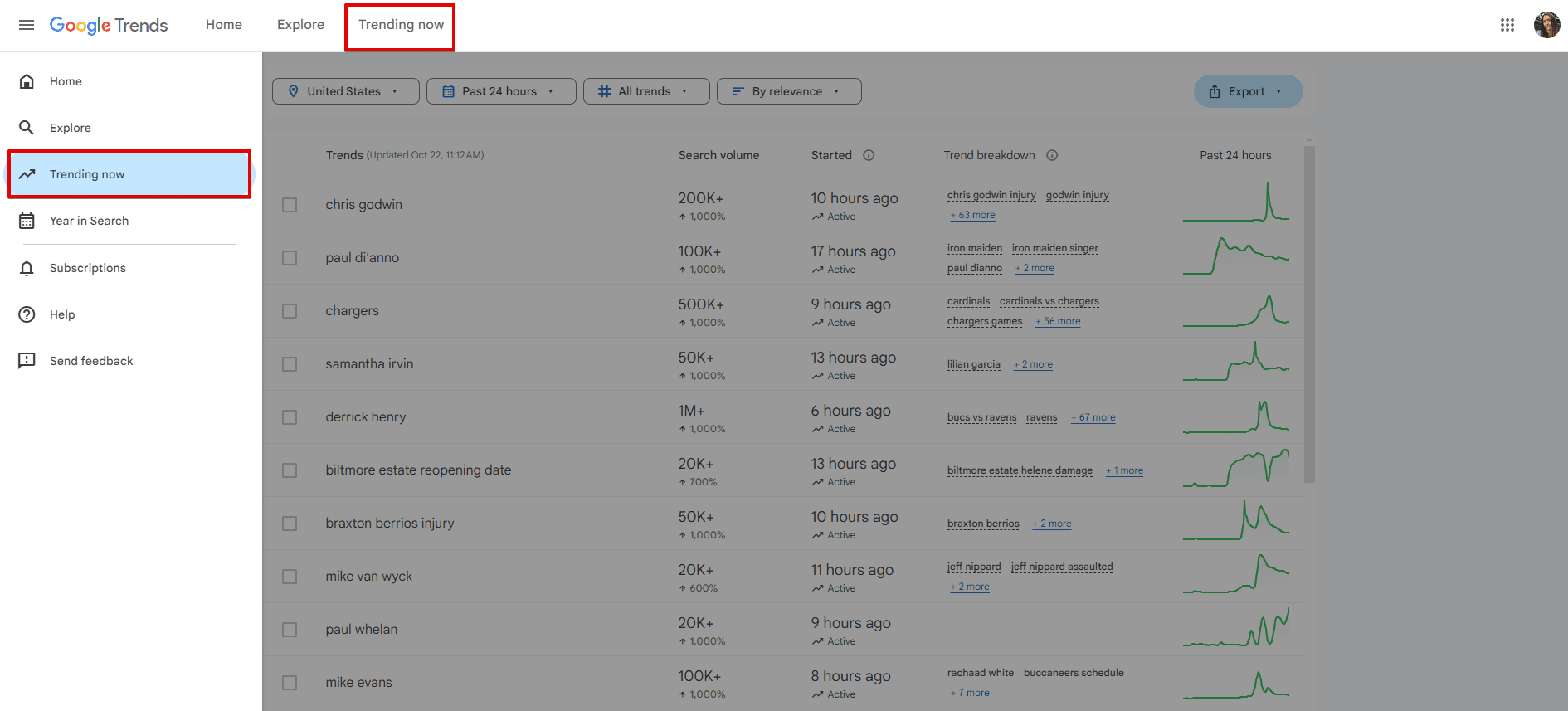
This new redesigned Trending Now section displays trending searches from over 100 countries and regions, with data refreshed every ten minutes. You can filter trends by country to focus on region-specific trends, adjust time ranges from the past 4 hours up to the past week, and sort by active trends, relevance, title, recency, and search volume.
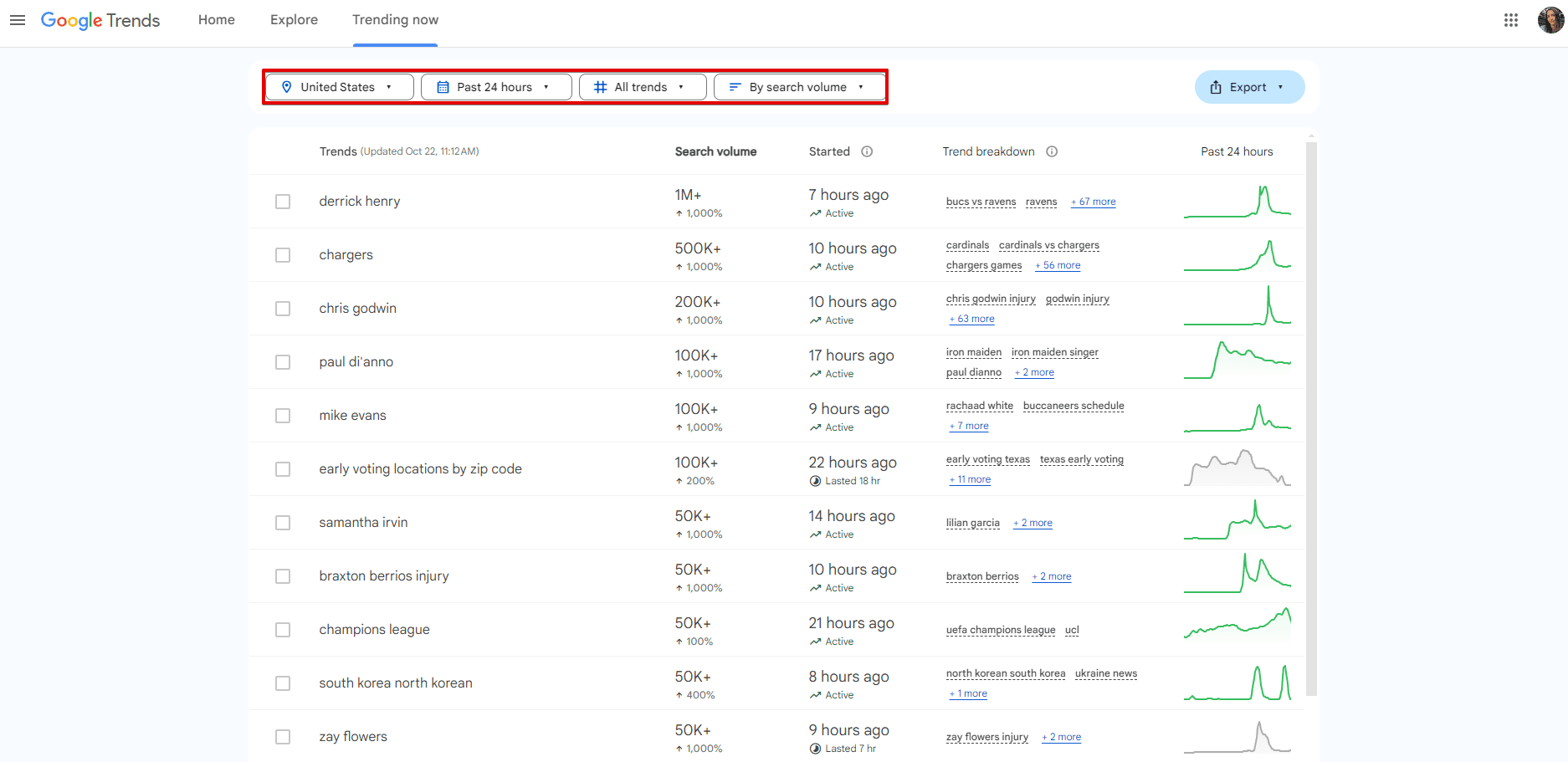
The new interface now displays more keyword data on a single page. For each trending query, you’ll see its search volume with growth percentage compared to the baseline, along with when the trend started and whether it’s still active or has ended.
Next to every popular search term, you’ll find a trend chart showing search volume changes over your selected timeframe and a detailed breakdown of related keywords making up the trend. All this data helps you understand whether a topic is worth covering and how to approach it.
Dive deeper into any trend by clicking on it.
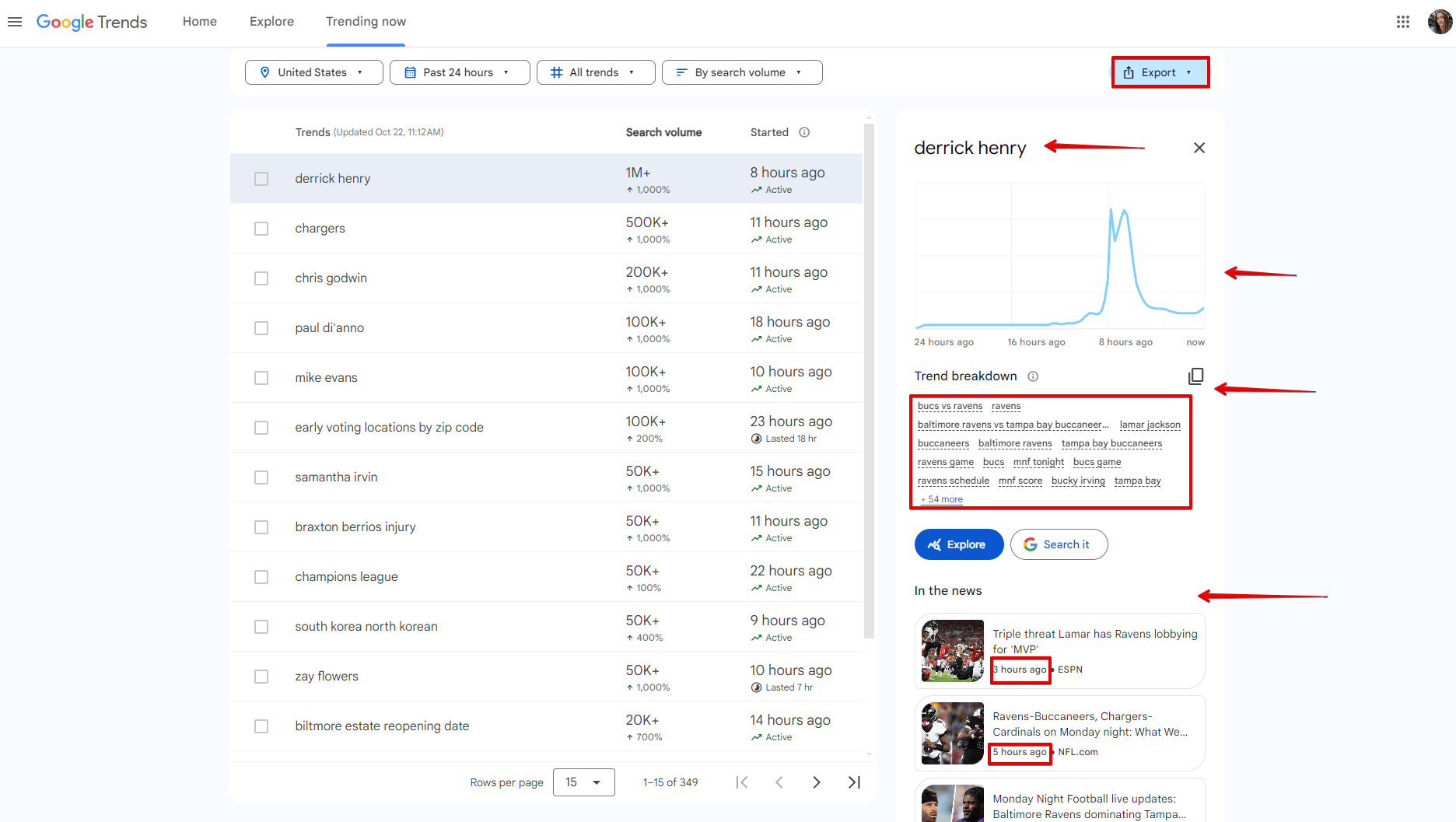
In the opened right-hand panel, you’ll discover related queries that compose the trend, a detailed trend chart for the past 24 hours showing exact-match data, and related news articles providing context about the trend. You can also click Explore to analyze the trend further in Google Trends or Search it to see the actual search results on Google.
Check out articles published by different media to see which events sparked people’s interest in a given keyword. For example, Derrick Henry, who showed a massive surge in searches (1M+ with 1,000% growth) during the Monday ***** Football Ravens-Buccaneers game, generated related trending searches including “bucs vs ravens”, “lamar jackson”, and “baltimore ravens”. The news articles from ESPN, NFL.com, and NBC News help explain this spike in interest and reveal the broader context of the trend.
Along with the article titles, you can also see exactly when they were published. If you see that a story was published a while ago, check the trend chart to ensure it hasn’t lost its appeal before creating content around it. Remember, trends can re-emerge even after they’ve ended, so keep monitoring topics relevant to your niche.
For deeper analysis, you can export the data via CSV, clipboard, or RSS feed, or compare up to five queries simultaneously.
Improve your local SEO strategy
Pick the best region to target
When you assess a keyword’s popularity using traditional keyword research tools, the data you get is the average for the country you’re analyzing. Google Trends is unique in this regard because it gives you the chance to observe how interest in your topic varies across the country or even across different cities in any given region.
The Interest by subregion section is located below the Interest over time graph. Here you can check which of the country’s regions (states for the US) show more interest in the topic. You can click on every subregion mentioned in the table to narrow down the location and see which cities within the state/region the searches come from.
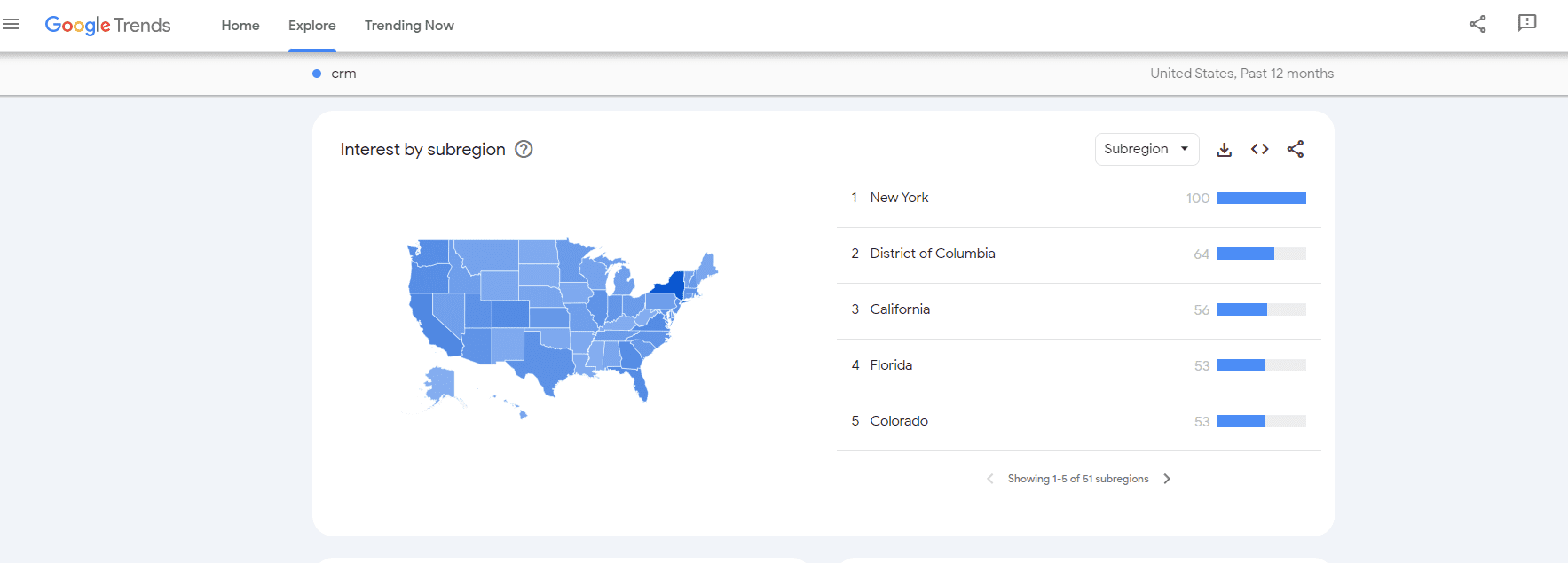
If your service is not location-dependent—so let’s say you sell CRM software—you can use Google Trends to see if your product is highest in demand in NY, District of Columbia, and California. You can then try location-based advertising to target these regions regardless of your physical location.
This feature is also useful for businesses whose physical location is irrelevant but want to promote location-dependent services. For example, maybe you want to start a review website that will get income from affiliate programs offered by yoga retreats, and you need to find out where these kinds of centers are in the greatest demand. Google Trends will prompt you to partner with rehabs in D.C., Vermont, Colorado, and Hawaii.
Find local keywords to target
From the Interest by subregion data, you can also uncover local keywords to target. Different regions often use different terms to search for the same services or products. For instance, one region might search for “yoga studio” while another uses “yoga center.” You can explore these regional variations by comparing interest in search terms within each location you’re targeting.
Use these insights to optimize your content and advertising for each location’s unique search patterns.
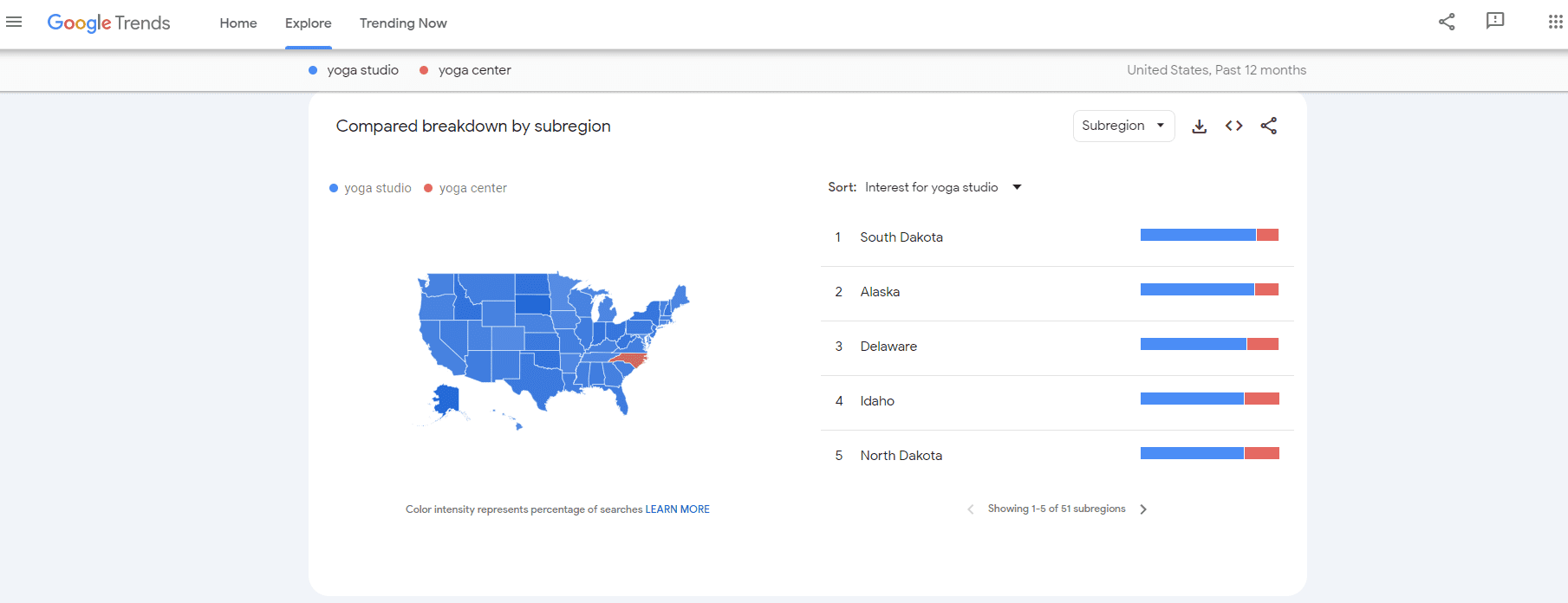
To make the most of these local insights, use local SEO tools like SE Ranking’s Local Marketing toolkit. It tracks local rankings, manages Google Business Profiles, maintains consistent business information across directories, and provides essential features to convert regional keyword insights into actual local search visibility.
Keep an eye on competitor trends
Just as you can compare multiple search terms, you can compare competitors to gauge your market position and spot areas for improvement.
Use the comparison feature in the search box. Enter multiple brand names (up to 5) and analyze their relative popularity. For instance, when comparing Netflix and Apple TV+, you can see a graph showing their relative search interest over time.
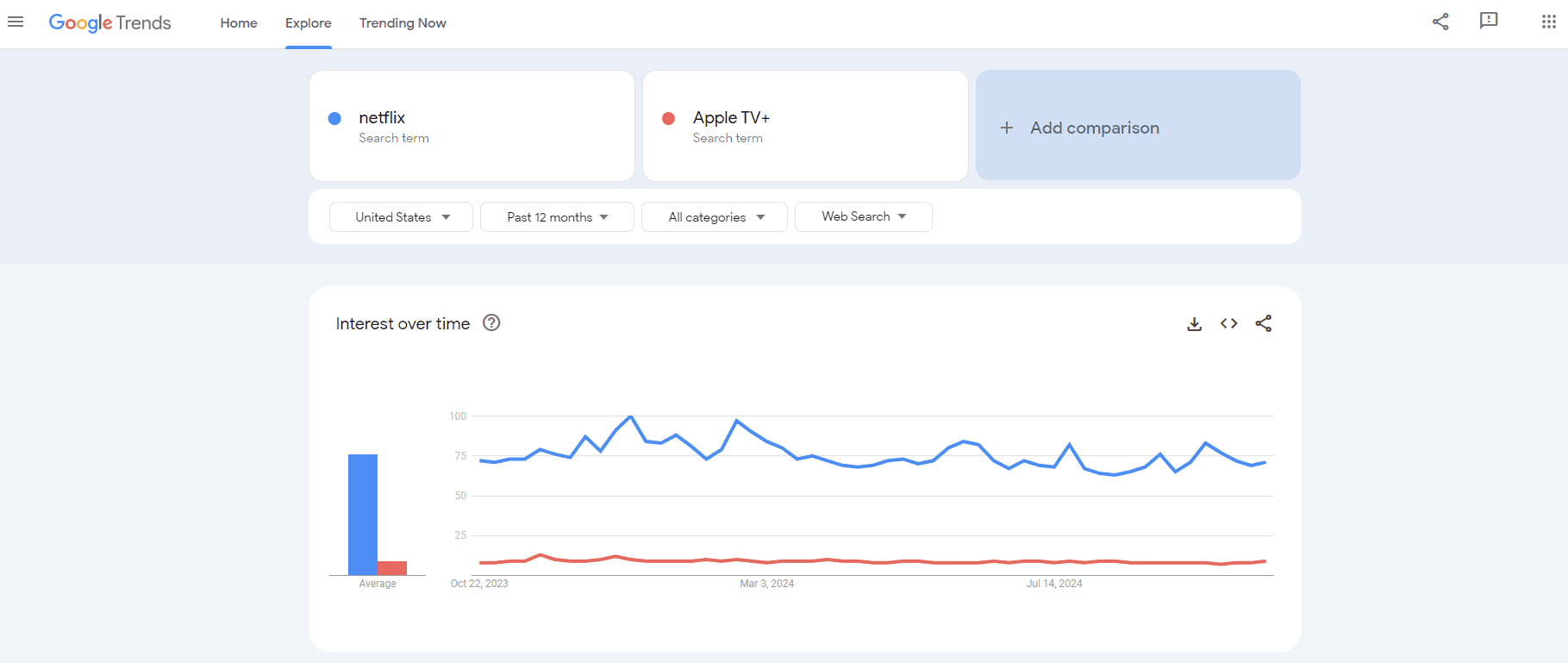
This graph also shows traffic spikes indicating successful marketing campaigns, product launches, or seasonal trends.
Below the graph is the Interest by subregion section, which shows you where each competitor generates more searches. You can click on any region to get city-level data.

This feature is especially useful when exploring related topics and queries. The sections below the comparison graph display what users are searching for in each streaming service.
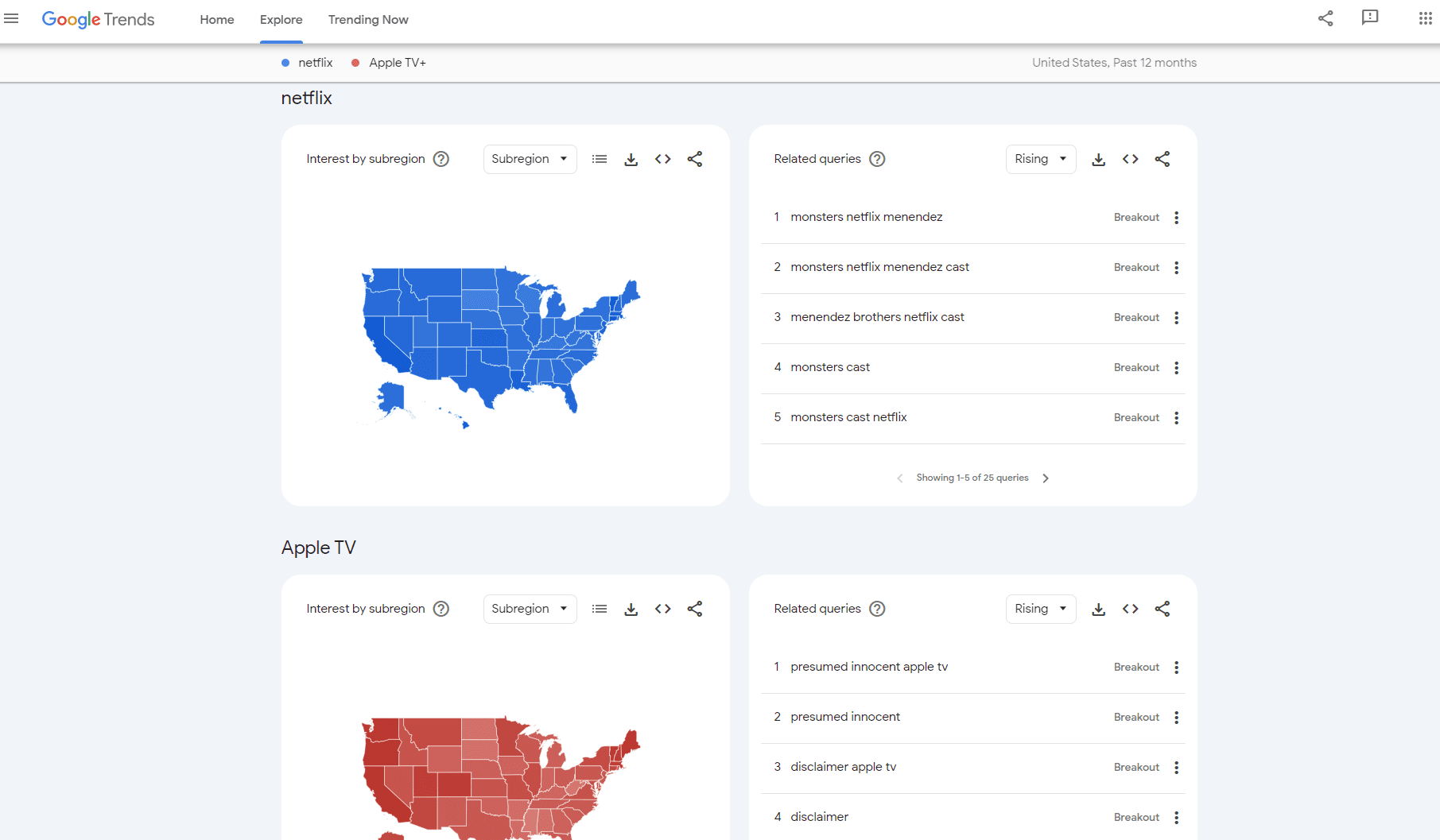
Looking at the Related queries sections and the traffic spikes we uncovered before gives you an understanding of what drove the surges in interest. This helps you identify successful strategies you might want to adapt for your own business and spot potential market opportunities.
For an even more comprehensive competitive analysis, combine this data with SE Ranking’s Competitive Research tool. It helps you analyze your competitors’ organic and paid strategies, see their traffic estimates, top-performing pages, keyword rankings with all essential SEO metrics and SERP features, changes in their visibility over time, and more. All this data together will help you better understand what works in your niche and strengthen your SEO strategy.
Enhance video and YouTube SEO
We’ve already touched on this when exploring search terms across both web searches and YouTube specifically. Google Trends is also a top keyword research tool for enhancing video content production and YouTube SEO.
To get started, enter your topic into the search box and change the search type from Web Search to YouTube Search using the dropdown menu. You can also select a specific category to get more relevant results. For instance, if you’re creating cooking videos, select the Food & Drink category.
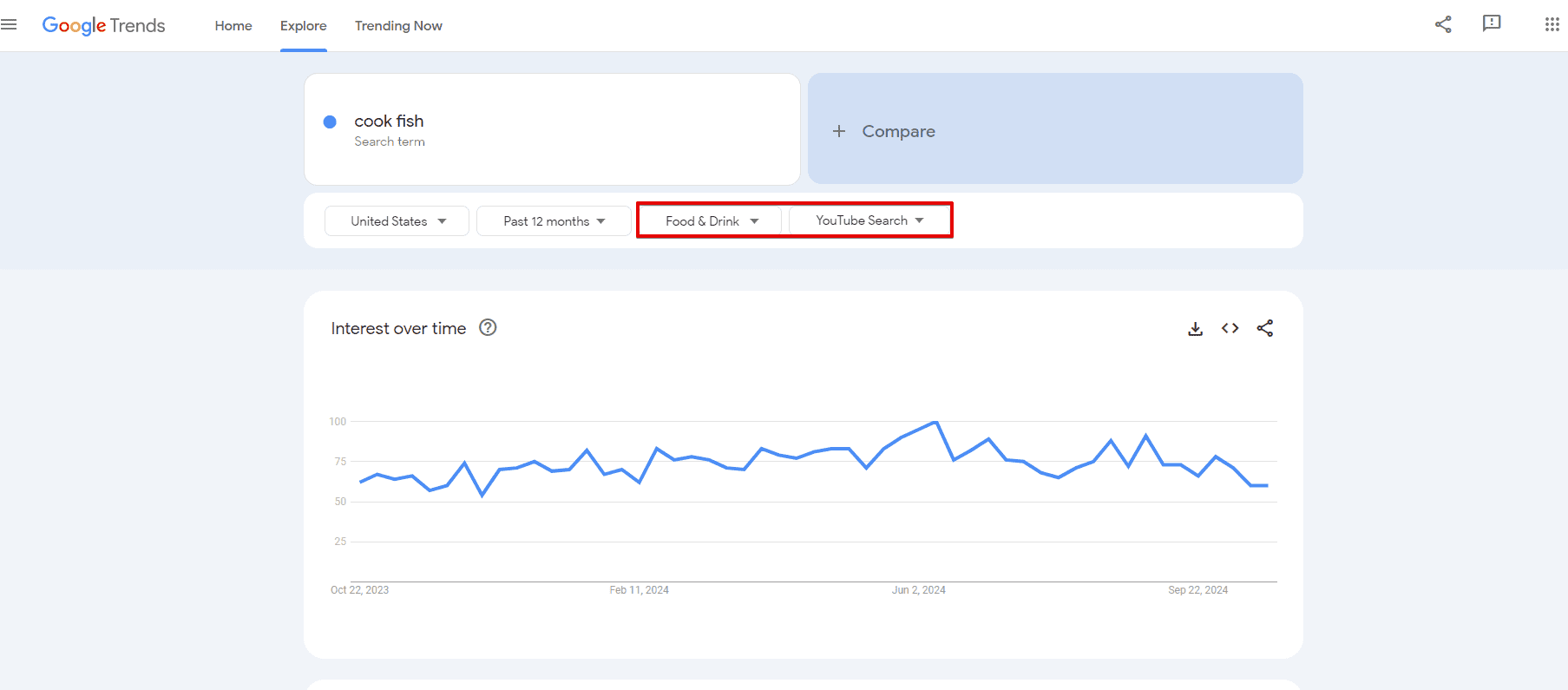
The Interest over time graph shows how YouTube searches for your topic have changed over time. Looking at our example of “cook fish,” the graph shows steady interest throughout the year, with notable peaks in June, indicating this could be a reliable topic for your channel.
You’ll also find the Related topics and Related queries sections below, which reveal other popular searches among your target audience. Use these insights to discover new video ideas and discover the type of content your viewers want.
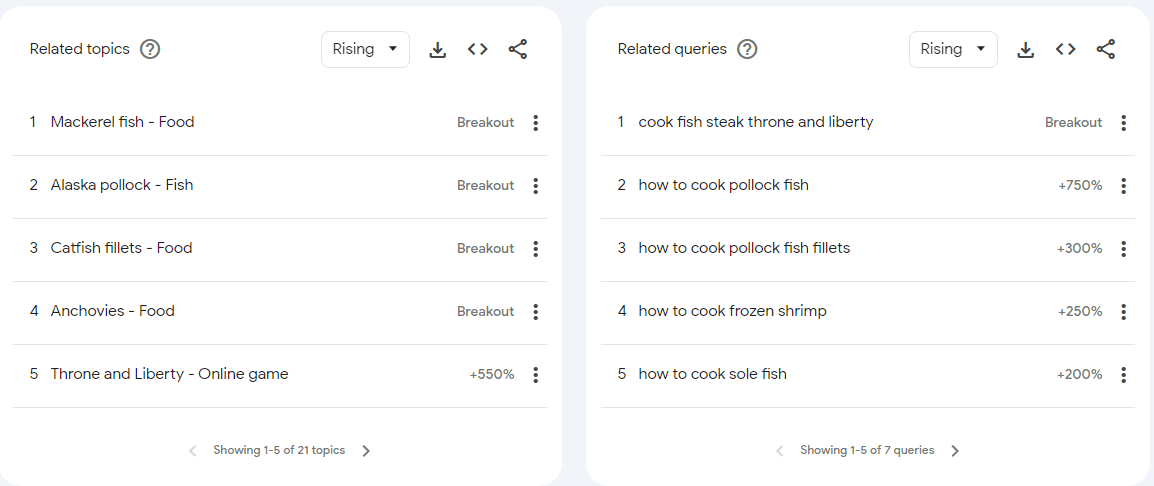
For “cook fish,” we can see growing interest in specific queries like “how to cook pollock fish” (750% increase) and “how to cook sole fish” (200% increase). We can use these insights to plan our video content further.
Closing thoughts
Most SEO specialists occasionally use Google Trends to check how collective interest in a keyword changes over time. Still, few of us use this tool to its fullest potential. Perform a proper Google Trends analysis to gain precious insights and make meaningful adjustments to your SEO strategy.
We hope that the tips shared in this post become a part of your regular SEO routine. Now that you’ve familiarized yourself with all of Google Trends’ sections and filters, you can use its data to perform a successful SEO analysis.
